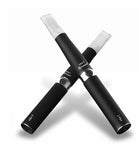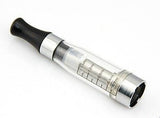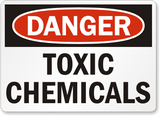Vaping vs. Smoking
 Electronic cigarettes are rooted in their ability to provide a viable alternative to traditional cigarettes. Herbert A. Gilbert first conceived the original technology in 1963, whose goal was to find a viable way for cigarette smokers to kick the life-threatening habit. The first forms of ecigs were extremely rudimentary compared to the technologically advanced devices available today; however, the general concept and configuration remains virtually unchanged. Although vaping technology existed over 50 ago, it was not popularized until 2011, when the first disposable devices were introduced to the market. Shorty thereafter, Joyetech released the first popular rechargeable vaporizer—the eGo-T Kit. This device consisted of essentially the same eGo-style batteries that exist today, coupled with a mouthpiece that acted as the e-juice reservoir. Although at the time this was the best rechargeable, reusable, and refillable device available, it was greatly flawed, as it held extremely small amount of e-juice, produced very little vapor, and tended to release e-liquid into the mouth of the user.
Electronic cigarettes are rooted in their ability to provide a viable alternative to traditional cigarettes. Herbert A. Gilbert first conceived the original technology in 1963, whose goal was to find a viable way for cigarette smokers to kick the life-threatening habit. The first forms of ecigs were extremely rudimentary compared to the technologically advanced devices available today; however, the general concept and configuration remains virtually unchanged. Although vaping technology existed over 50 ago, it was not popularized until 2011, when the first disposable devices were introduced to the market. Shorty thereafter, Joyetech released the first popular rechargeable vaporizer—the eGo-T Kit. This device consisted of essentially the same eGo-style batteries that exist today, coupled with a mouthpiece that acted as the e-juice reservoir. Although at the time this was the best rechargeable, reusable, and refillable device available, it was greatly flawed, as it held extremely small amount of e-juice, produced very little vapor, and tended to release e-liquid into the mouth of the user.
Not long after Joyetech introduced the Ego-T and later the eGo-C, another player entered the market, and forever changed the landscape and direction of the vaping industry—Kangertech. Kanger initially focused on manufacturing devices that resembled analog cigarettes, making them similar is size and shape, as well as including an end-cap that glowed when taking a hit. However, Kanger’s approach was different to that of Joyetech, as they engineered cartomizers that contained filament and coils. This was a superior design, as it enabled the user to store more e-juice, delivered better flavor, manufactured larger vapor clouds, and eliminated leaking into the mouth.
the market, and forever changed the landscape and direction of the vaping industry—Kangertech. Kanger initially focused on manufacturing devices that resembled analog cigarettes, making them similar is size and shape, as well as including an end-cap that glowed when taking a hit. However, Kanger’s approach was different to that of Joyetech, as they engineered cartomizers that contained filament and coils. This was a superior design, as it enabled the user to store more e-juice, delivered better flavor, manufactured larger vapor clouds, and eliminated leaking into the mouth.
 Building upon this technology, Kangertech then diligently researched ways to further enhance the vaping experience. Their efforts ultimately culminated in the world’s first clearomizer (tank)—the technology of which is utilized to this day. The Kanger CE4 was revolutionary, as it allowed you to monitor the remaining amount of e-liquid that remained in the tank, which the user was unable to do with the Kanger cartomizers. Although refillable, these tanks were disposable, as the atomizer coils could not be replaced once it had burned out. Not long after the release of the CE4, Kanger introduced the T2 Tank, which added the bonus feature of replaceable atomizer coils. This was a very beneficial capability, as it dramatically reduced the cost associated with vaping since replacing solely the coil is substantially less expensive than purchasing an entirely new tank. This early technology set the stage for what has very rapidly progressed into ultra-advanced devices, which includes an ever-increasing array of features and customization options.
Building upon this technology, Kangertech then diligently researched ways to further enhance the vaping experience. Their efforts ultimately culminated in the world’s first clearomizer (tank)—the technology of which is utilized to this day. The Kanger CE4 was revolutionary, as it allowed you to monitor the remaining amount of e-liquid that remained in the tank, which the user was unable to do with the Kanger cartomizers. Although refillable, these tanks were disposable, as the atomizer coils could not be replaced once it had burned out. Not long after the release of the CE4, Kanger introduced the T2 Tank, which added the bonus feature of replaceable atomizer coils. This was a very beneficial capability, as it dramatically reduced the cost associated with vaping since replacing solely the coil is substantially less expensive than purchasing an entirely new tank. This early technology set the stage for what has very rapidly progressed into ultra-advanced devices, which includes an ever-increasing array of features and customization options.
However, irrespective of the level of technological advancement the vaping industry has enjoyed over the years, the fundamental functionality remains virtually unchanged. That is, even the most progressive devices still use batteries to heat atomizer coils, which in turn vaporize e-juice. Likewise, e-juice is still made with vegetable glycerin (VG), propylene glycol (PG), nicotine, and flavors.
Cigarettes naturally have an extensively longer history than ecigs. Dating as far back as 5,000 B.C., tobacco cigarettes have been around for over 7,000 years. What began as Shamanistic rituals very swiftly spread in terms of cultivation and use with the arrival of the Europeans in the 16th century. Although early forms of cigarettes were 100% natural, and included absolutely no chemicals, impurities, or additives, Fritz Lickint noted the link between smoking and lung cancer in the mid1920s.
As time progressed and technology advanced, the large tobacco manufacturers began
finding ways in which to not only reduce the cost of manufacturing cigarettes, but also developed ways to make them more addictive. Artificial additives began being introduced to the tobacco, in an effort to make them even more habit-forming. Modern day cigarettes are inundated with thousands of harmful and addictive chemicals and compounds, making them more dangerous than ever.
Although smoking and vaping both involve inhaling a substance, then exhaling it, they share very little else in common. The act of vaping is a stark contrast to smoking analog cigarettes in a vast array of forms and fashions, making them entirely different and distinct activities.
Ingredients:
One of the primary differences between smoking and vaping is undoubtedly the ingredients that make up the individual products. As is widely known, cigarettes are made with tobacco leaves, which are generally cured, dried, and shredded. Although in the earliest days of cigarette manufacturing, the natural tobacco leaves were then rolled and wrapped within paper to be smoked, those days are long gone.
 The supermajority of tobacco that is used in cigarettes today are riddled with thousands upon thousands of chemicals and impurities prior to be rolled. In fact, a mind-blowing 4,000+ chemicals go into each and every cigarette that is consumed today—69 of which are indisputably known to cause cancer. Poisons, such as carbon monoxide, arsenic, hydrogen cyanide, methoprene, freon, tar, formaldehyde, butane, and cyanide are just some of the deadly chemicals that are included in tobacco cigarettes. Even small amounts of any one of these contaminants has been definitively proven to cause cancer as well as a seemingly endless range of other fatal diseases.
The supermajority of tobacco that is used in cigarettes today are riddled with thousands upon thousands of chemicals and impurities prior to be rolled. In fact, a mind-blowing 4,000+ chemicals go into each and every cigarette that is consumed today—69 of which are indisputably known to cause cancer. Poisons, such as carbon monoxide, arsenic, hydrogen cyanide, methoprene, freon, tar, formaldehyde, butane, and cyanide are just some of the deadly chemicals that are included in tobacco cigarettes. Even small amounts of any one of these contaminants has been definitively proven to cause cancer as well as a seemingly endless range of other fatal diseases.
The ingredients that are contained within e-juices, on the other hand, consist of propylene glycol, vegetable glycerin, nicotine, and flavors. Of course, while some Chinese liquids may contain a range of impurities, such as formaldehyde, American e-juices generally do not. Unlike cigarettes, the ingredients of which are used in items such as poisons, the components used to make e-liquid can be found in a vast spectrum of everyday products.
Propylene glycol is very commonly used in consumable goods, such as ice cream,
sweetener, icing, soft drinks, margarine, cake mix, ranch dressing, barbecue sauce, flavored coffee, Fireball Whiskey, flavored teas, and virtually all Entenmann’s desserts, among many others. Likewise, vegetable glycerin is also found in a host of everyday consumer products, such as cheese, flavored yogurt, powdered milk, canned vegetables, canned fruits, pasta sauce, rolled oats, tapioca pudding, rice, vinegar, mustard, and a wide range of other items.
In line with the vegetable glycerin and propylene glycol, the flavorings that are used for premium USA-made e-liquid are the same as that which is used in various foodstuffs. Candy, gum, mints, drinks, desserts, and a plethora of foods use these flavorings in various ingestible products.
Inhalation:
\As is widely known and understood, smoking requires using fire to light the end of a cigarette. Once lit, the tobacco plant matter, along with 4,000+ chemicals it is spiked with, is burned to produce smoke. The paper, which is used to roll and contain the laced tobacco, is bleached to appear white, and is also burned along with the tobacco. The burning of these materials produces smoke, which is then inhaled into the lungs. It is a well-known and documented fact that all smoke, irrespective of the material being burned, is carcinogenic and causes cancer. Add to this the thousands of chemicals and the tar contained within cigarettes, and the result is an extremely dangerous and deadly activity.
Conversely, vaping does not involve the burning of any matter whatsoever. Electronic cigarettes operate by e-juice being fed to a coiled wire via cotton wicks. When the battery is activated, it causes the coil to heat, thereby vaporizing the liquid. Without any burning or smoke involved in the process, the vapor produced by electronic cigarettes has not been found to be carcinogenic. In fact, according to a recent extensive study conducted by Public Health England (PHE) in the United Kingdom, vaping was found to be 95% less harmful than smoking cigarettes.
Odor:
 Anyone who has been around a cigarette smoker can attest to the fact that not only does the cigarette itself produce a genuinely foul and ghastly odor while it is being smoked, the residual smell left on the smoker’s fingers, clothes, hair, and breath is equally offensive, if not more so. This stench, although clearly apparent to all, is particularly stark for those who do not smoke.
Anyone who has been around a cigarette smoker can attest to the fact that not only does the cigarette itself produce a genuinely foul and ghastly odor while it is being smoked, the residual smell left on the smoker’s fingers, clothes, hair, and breath is equally offensive, if not more so. This stench, although clearly apparent to all, is particularly stark for those who do not smoke.
Vaping, on the other hand, does not emit unpleasant odors of any sort. In fact, the vast majority of e-juices release very pleasant aromas of fruit, dessert, candy, and drinks, which often invite compliments from those in close proximity. Moreover, the vapor produced from electronic cigarettes never lingers on an individual’s clothes or body, nor does it cause a foul odor when used within cars or inside buildings the way cigarettes do.
Staining:
As is commonly seen and recognized, smoking cigarettes causes permanent staining to the smoker’s teeth. These brown blemishes appear over time, and can be seen throughout the mouth, particularly on the front teeth. Long-time smokers will also begin to notice blackened gums and lips, as well as spots on the fingers where the cigarette is typically held.
the smoker’s teeth. These brown blemishes appear over time, and can be seen throughout the mouth, particularly on the front teeth. Long-time smokers will also begin to notice blackened gums and lips, as well as spots on the fingers where the cigarette is typically held.
Vaping, on the other hand, does not cause any spots or stains of any sort. The clear vapor that is produced from e-liquids does not blemish the teeth, nor does it blacken the gums or lips. This is true irrespective of how heavy of a vaper an individual may be.
Cleanliness:
Any and all smokers would be lying if they didn’t admit that smoking is a dirty habit. Due to the ash that is left behind once the tobacco and paper has burned, smoking leaves residue anywhere it is performed. Cars, patios, porches, rooms, etc. will always have some level of ash visible, regardless of how clean a smoker may be. Rather, this is an unavoidable consequence of smoking cigarettes.
However, using electronic cigarettes leaves absolutely no particles behind, as nothing is burned during the vaping process. This makes vaping a markedly cleaner activity when compared to smoking.
Conclusion:
As can be clearly seen, the act of vaping versus smoking is entirely contrary to one another. They are not only wholly different in terms of their ingredients and effects, but also very much so as a way of life.










